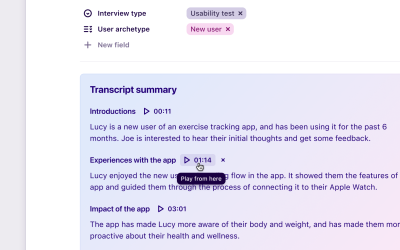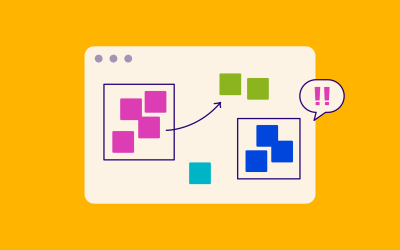What to do before building your research repository

How to pitch a research repository to your stakeholders
To empower your team to build context, you might consider socializing articles and blogs about research repositories ahead of time.
Nielsen Norman Group (NN/g) is a notable UX research and consulting firm founded by pioneers in the user experience field, Jakob Nielsen and Don Norman. We suggest circulating their seminal article research repositories for tracking UX research and growing your ResearchOps
You could also distribute this end-to-end article about how a research repository can solve your organization’s research problems on our blog. The article covers organizations’ common issues and explores how an excellent research repository solves those problems
A Design Researcher at Liferay and Dovetail customer, Miriam Manso, wrote this article on creating a research repository with Dovetail. It’s always beneficial to highlight how other organizations are doing things when trying to sell a concept
Some folks might want to know that other people are creating repositories to be swayed; they need social proof. For them, you might want to check out why we built a UX research insights repository by Gitlab
Center the problem for your organization
When you’re trying to secure buy-in from your organization or leadership, you should center your pitch on the problem that a UX research repository would solve for your organization.
Problem: We struggle to get team members and stakeholders up to speed
Pitch: People don’t know what to look for because there’s no single place that houses our customer knowledge, and they’re scrambling for the signal in the noise, the needle in the haystack. Dovetail is a single, central place where all our research and customer information could live. All our reports, notes, recordings, files, and images are in one place that’s searchable and easily accessible. Any new team member can effortlessly tap into this single source of truth for our entire customer knowledge base and painlessly get up to speed.
Top tip: Jump into Dovetail today and curate a “start here” project containing all the essential information a new colleague should internalize.
Problem: We find it hard to scale and standardize customer knowledge
Pitch: Dovetail is approachable for anyone conducting, consuming, or engaging with our customer knowledge. While written reports and presentations have been our ‘go-to’ for sharing user research insights, they’re usually inaccessible to the broader organization unless we’ve got a standardized home. They’re often shared spontaneously over email and chat or lost in some drive somewhere. There isn’t a clear place for people to learn about our customers. Dovetail brings consistency and makes it easier to store, search, and leverage past research and insights.
Problem: Different teams are talking to customers, but those teams aren’t talking to each other...
Pitch: Customer research is conducted in various ways across our organization, and different research processes, data analysis methodologies, tools, and formats for insights can cause silos. It’s normal for people to do customer research differently, analyze their data with various tools, and publish data, reports, and updates across multiple formats and products. So our customer knowledge repository has to be flexible enough to work for various data types, methodologies, and organizational structures, while also integrating with our other tools.
Problem: We duplicate research
Pitch: When someone joins a team or project, they might ask the same questions or run similar research projects to those that have come before them. This isn’t ideal because the organizational cost of relearning is expensive. With Dovetail, we can “remix” previous research in real-time and leverage our cumulative customer knowledge to make informed product decisions. We can then ask questions or run research that builds on this.
Top tip: Come with some examples of repeated research to bolster the pitch.
Mapping out your current customer knowledge before building your research repository
Before considering the functionality and usability of your research repository, you should take stock of where you are on the journey to genuinely centralized and accessible customer knowledge. Almost all teams conduct user research, even if they don’t explicitly call it that. As the volume of user feedback has grown, managing that research data, gleaning actionable insights, and collaborating cross-functionally has become more complex. We want to help you and your team map the types and formats of customer knowledge that you might want to incorporate into your user research repository.
Who to involve in this process
You’ll want to include the teammates that’ll be contributing or consuming content in your workspace to get a holistic picture of your current customer knowledge landscape. We suggest collaborating with the following roles and functions.
Customer success
User or UX researcher
UX team
Research team
Product team
Product managers
UX design and product design teams
Marketing
Level set on the goal with your team
You’ll want to map out the sources of customer data with your team. You could do this by running a live workshop, an online workshop with a digital whiteboarding tool, or an asynchronous exercise. Let your team know that the goal is simply to map out our current customer knowledge before building our research repository. Instead of solving for a future ideal state, everyone should reflect on where things are currently at—to take stock, not opine on the value of including specific types of customer knowledge in your research repository.
Document the current data landscape
Ask your team to document the types of user research or customer knowledge they engage with weekly, monthly, or yearly. We’ve got a list of examples here to get you started.
User interviews
Prototype and usability tests
Prospect calls or emails
Win/loss interviews
Support topics
Market research and focus groups
Social media feedback
HR feedback surveys
Net promoter score surveys
In-product feedback
Research study notes
User research reports
Video Interviews
Transcripts
Support tickets
NPS surveys
Surveys
Testing sessions
App reviews
Short user stories
In-depth summaries
Research results
Identify the locations where you currently keep raw data and research findings
You and your team should review the customer knowledge types and identify the locations where this data is currently housed (to the best of their knowledge). We’ve got a list of examples here to get you started.
Added bonus: Some of them are integrations you can seamlessly connect to Dovetail today.
Google docs/PDFs
Reports/slides
Wikis
Excel/spreadsheets
Airtable
Deciding what data to include when building your repository
After considering all the different forms of customer knowledge that you could incorporate into your repository, you’ll need to figure out the complexity of importing and transforming it into a format that makes sense for your organization.
The type of data you decide to centralize in your customer knowledge repository should help your team get closer to the customer and answer customer questions quickly. Ultimately, it should help you and your team make better decisions and empathize with customers.
Your organization might have a lot of historical data collected, so it can seem like a mammoth task to import all your past data, but we’ve got some tips and tricks to simplify it.
Start your research repository from scratch
Whether it’s really worth it is ultimately up to each organization to decide how valuable that stuff is. Many of our customers draw a line in the sand and decide to start fresh. This is by far the most straightforward, cost-effective option; however, some researchers and organizations don’t feel comfortable excluding past research.
Add things to your research repository incrementally
You may be overwhelmed by the sheer amount of existing customer data you have, particularly unstructured qualitative data, and you might opt for the gradual rollout. There are a couple of ways you could slice and dice your data, including:
By methodology. You might consider some methods useful on an ongoing basis but not others. For example, you might add your video interviews but not your past survey responses.
By project. You might not see all your past research projects as equally important. This could result in you importing data on a project-by-project basis.
By time. You might decide on a cut-off point for importing past research. For example, you might focus on just the past three, six, or twelve months.
Add only research output to your research repository
You might decide that you only want to pull in the output of past customer research. This would mean importing past research findings and insights instead of raw research data.
When including the output, you might want to standardize your research outputs for findability, potentially including the following elements:
Name and status of the project.
Name, contact details, and the team of the person responsible for the research.
A couple of tags or create a taxonomy to increase the likelihood of findability.
Unsure about where to start with your research repository
For those folks who aren’t sure about the best approach, you could begin by triaging your current customer knowledge sources into two clear buckets:
Have to have: This could include your recent finalized research reports, your JTBD frameworks, or your research insights.
Good to have: This could include your older finalized research reports, your in-progress research projects, or research mapped to particular personas.
You’d want to start importing everything in the have to have column into your repository and add the good to have on a project-by-project basis.
How will your research repository operate?
Regardless of your approach, there are still some outstanding workflow questions you’ll want to answer before sending your research repository live. Including:
What resources are you going to dedicate to this project?
Who will the repository owner be?
Can anyone add content to your repository?
What type of content can be added?
Is there a standardized format for data to be added?
What is the name of the repository?
What’s the structure and hierarchy in which things are stored and documented?
What metadata should be submitted along with the resource?
Would it be easier to set up templates from the get-go?
And there it is! Hopefully you’ve got this far and feel more than ready to make the big pitch for a research repository and move your org up a few rungs on the UX research maturity scale in the process.
Get started for free
Log in or sign up
Get started for free
or
By clicking “Continue with Google / Email” you agree to our User Terms of Service and Privacy Policy


